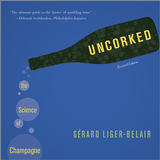Uncorked: the science of champagne
| Title of book: | Uncorked |
| Author: | Gérard Liger-Belair |
| Publisher: | Princeton University Press |
| Publication date: | 2013 |
| ISBN | 978-0-691-158726 |
| Pages: | 194 |
| Price: | £16.95 / US$24.95 |
 Gérard Liger-Belair is a physics professor at the University of Reims, located in the Champagne region of France. And his book is all about bubbles. Bubbles of and in Champagne.
Gérard Liger-Belair is a physics professor at the University of Reims, located in the Champagne region of France. And his book is all about bubbles. Bubbles of and in Champagne.
You’ll never again look at a glass of bubbly in the same way (though you may irresistibly find yourself comparing the bubbles in beer and bubbly. You’ll need one of each, side by side).
The huge spacing between lines gives this book a bit of an easy-reading feel, upon first opening. It also completely belies the depth of science of the bubble that author expounds upon. Don’t be lulled into a false sense of security when you start this book.
There’s just the perfect dollop of historical perspective for context (including the English precedent of producing sparkling wine, thanks to strong glass). And you can start your journey in this book knowing pretty much nothing about wine. For example, the author tells us chardonnay is a white grape, pinot noir a dark one. We’re lead through the production steps from the fermentation of a base wine, the blending, the second fermentation. It’s all nicely easy and readable …
I failed. I was completely lulled into that false sense of security by this point, just a short distance into the book. Now, Liger-Belair whacks you with the science, explaining Henry’s law and Van de Waals attractive forces, as well as bubble nucleation. Hang on in there for the ride though. This is fascinating.
Henry’s law explains why bubbles are formed – something about re-establishing an equilibrium of carbon dioxide in the wine and the atmosphere of a newly opened bottle. To do this the carbon dioxide dissolved in the champagne has to escape. But before they can escape bubbles need to form (nucleate).
Bubbles need pre-existing gas cavities of at least around 0.2µm radius in order to form. Such production sites are usually tiny bits of dust and fibre (yum) that have landed on the glass wall. But without them, champagne doesn’t bubble, the carbon dioxide would just escape from the top of the wine. Images from a camera able to take 3,000 frames per second illustrate the process.
And here’s one for quiz night: the average bubble is about 500µm in diameter (that’s one millionth of a metre). Though they’re only about 10µm when they leave their point of nucleation to grow, and rise to the surface.
We learn about the lifespan of a bubble – it varies according to which planet we might be on – which ends with its bursting via an illuminating iceberg comparison. A bit of Rayleigh-Plateau instability and jet drops later and the bubble has burst in a chain reaction of avalanche behaviour.
Liger-Belair explains all this science stuff brilliantly for the lay person. He litters the book with tiny scale images showing bubbles doing amazing things – what bubbles do, I guess. This is the first time I’ve been SO engrossed by a bubble.



